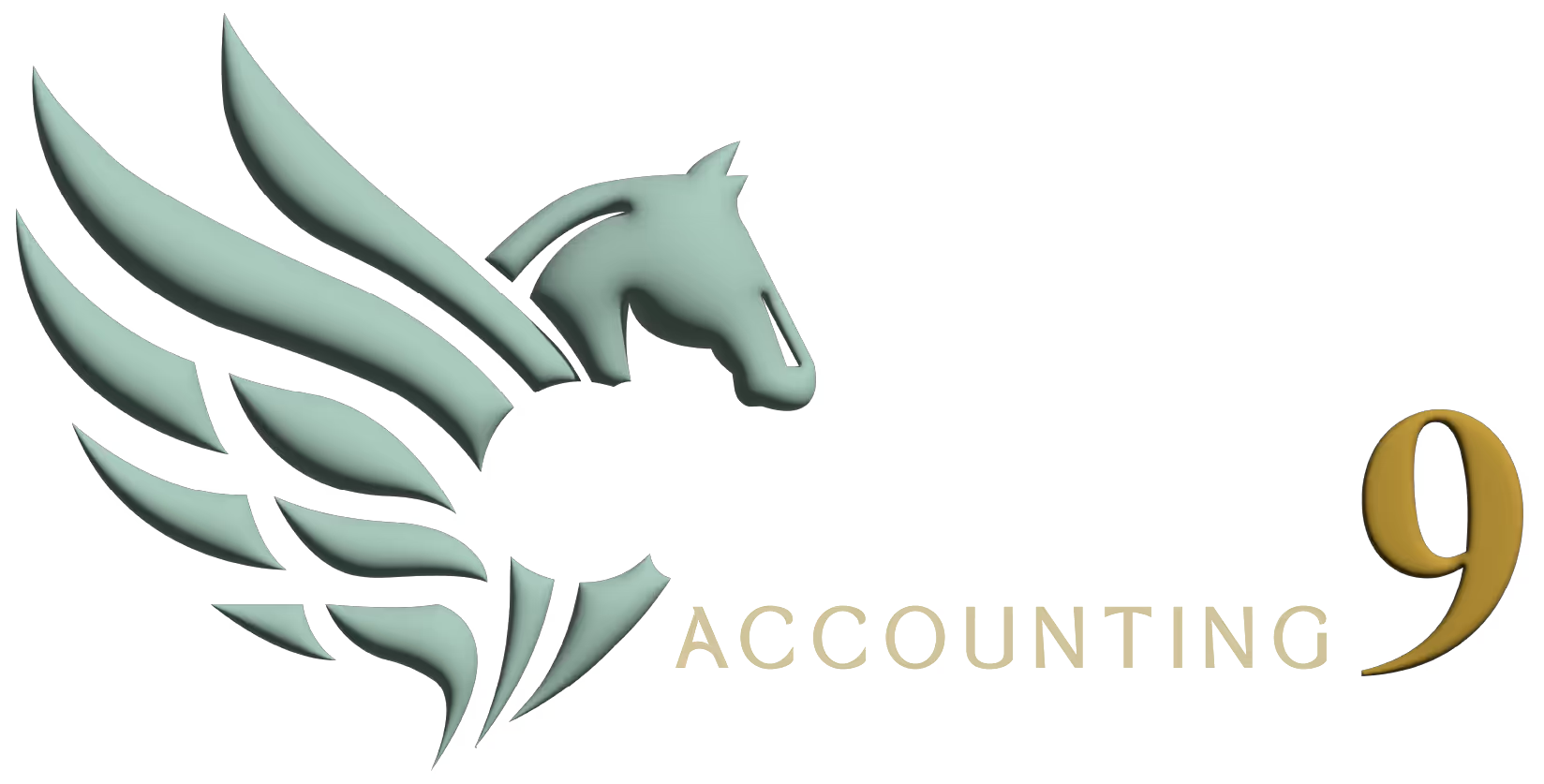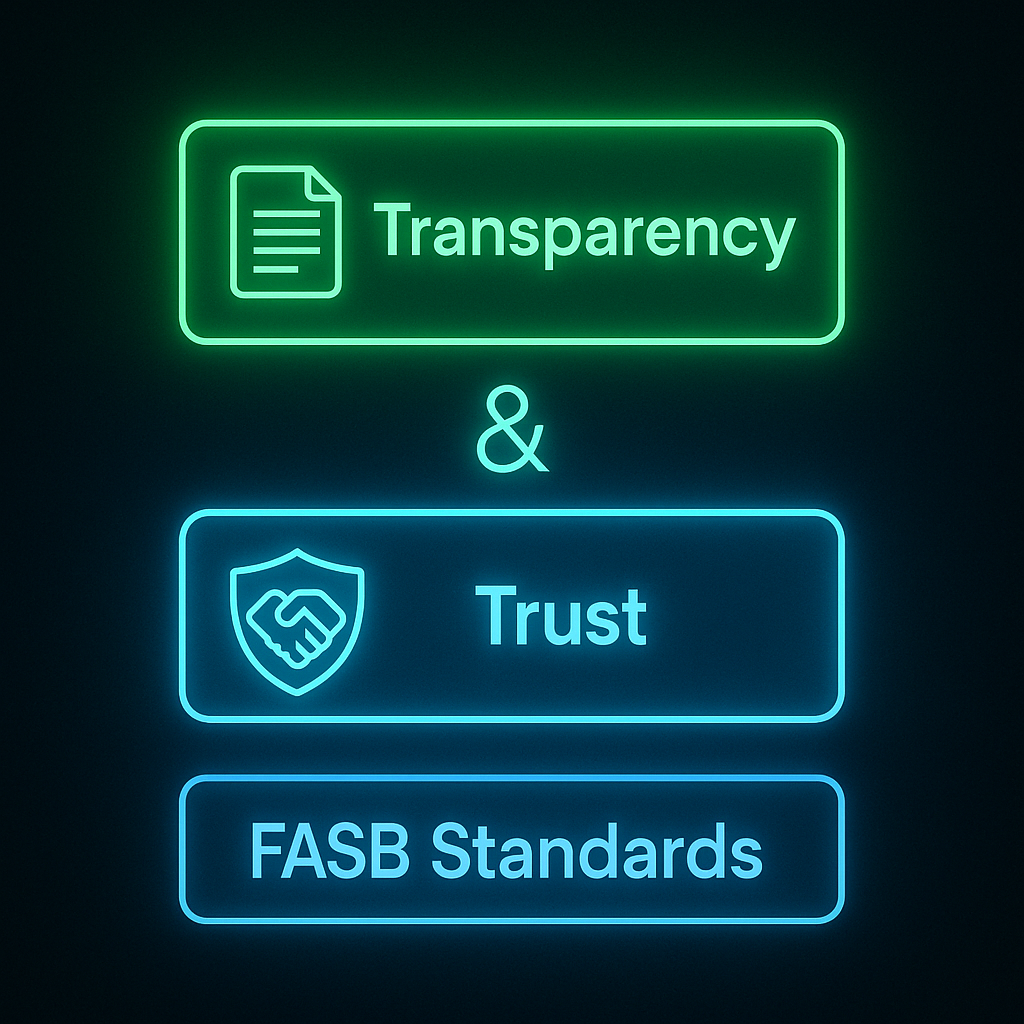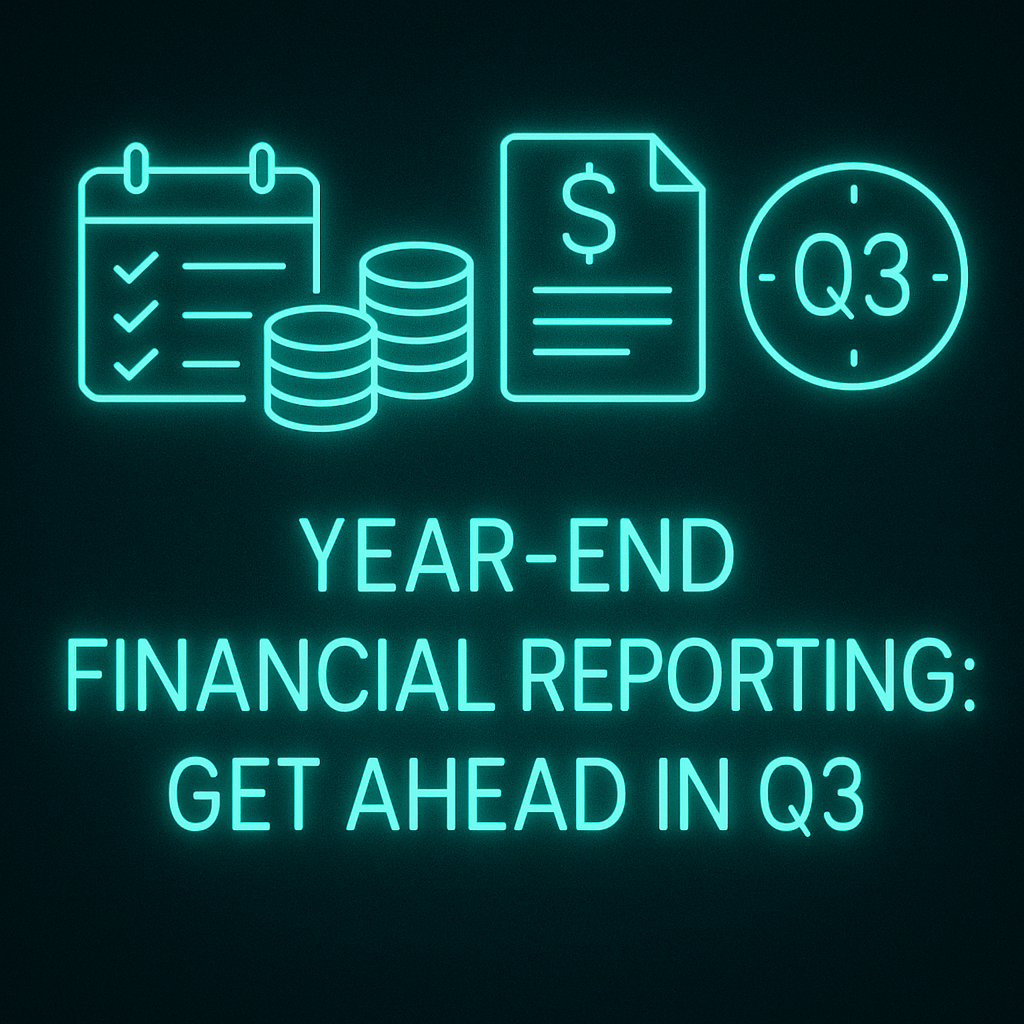Cash vs. Accrual Accounting: A Deep Dive for Business Owners
Understanding the difference between cash and accrual accounting is essential for small business and nonprofit owners. Cash accounting tracks money when it moves, while accrual accounting records income and expenses when they’re earned or incurred, offering a clearer financial picture. This blog breaks down both methods, highlights their pros and cons, explains IRS rules and GAAP standards, and helps you decide which is right for your organization. Whether you’re just starting out or planning to scale, choosing the right method can impact everything from taxes to long-term growth.

When it comes to managing your business finances, the accounting method you choose can dramatically impact how you view your company’s performance, make decisions, and comply with tax regulations. The two primary accounting methods—cash basis and accrual basis—each offer distinct advantages and challenges. In this comprehensive guide, we’ll break down cash vs. accrual accounting in plain language. Whether you’re a small business owner or a nonprofit director with little accounting background, you’ll learn the key differences, historical context, and practical implications of each method. By the end, you should have a clear understanding of which method fits your organization and why it matters.
What Is Cash Accounting (Cash Basis)?
Cash accounting is a straightforward method where transactions are recorded only when cash actually changes hands. In other words, income is recognized when you receive payment, and expenses are recorded when you pay out cash. This method is much like balancing your personal checkbook – it focuses solely on the cash flow in and out of your accounts.
- How It Works: If you send an invoice today but don’t get paid until next month, cash-basis accounting says you haven’t earned any revenue until the money hits your bank. Similarly, an expense isn’t counted until you’ve actually paid it. There are no accounts receivable or accounts payable on your books, because everything is based on real money movements.
- Key Features: Simplicity is the big draw. Cash accounting is easy to implement and understand. It provides a real-time snapshot of your cash flow – you always know how much cash you have available, which can be very useful for day-to-day decision-making. Many small businesses and sole proprietors prefer this method for its no-nonsense approach.
- Example: Suppose you invoice a client in July for $5,000. The client pays in August. Under cash accounting, you record that $5,000 as revenue in August, when the cash is received, not in July when you issued the invoice. The same timing applies to expenses: if you incur a bill in July but pay it in August, the expense counts in August.
- Who Uses Cash Basis: Cash accounting is commonly used by very small businesses, freelancers, consultants, and other cash-based businesses with straightforward finances. In fact, it’s so prevalent among small companies that as of 2022 roughly 67% of small businesses in the U.S. use cash-basis accounting outoftheboxtechnology.com. It’s often the default choice for businesses that do not carry inventory and for those who want to keep things simple for tax purposes.
- Tax Simplicity: Under U.S. tax law, many small businesses are allowed to file taxes on a cash basis, which means you only pay income tax on money you have actually received during the year. This can offer some tax planning flexibility – for example, you might delay sending out certain invoices until January to push the taxable income into the next year, or accelerate paying some expenses in December to increase deductions. (Always consult a tax professional before attempting such strategies.)
Pros of Cash Accounting:
- Simplicity: Easiest method to maintain, with minimal accounting knowledge needed. You can often manage it yourself or with basic bookkeeping help. Income and expenses are recorded in one step when cash moves, avoiding complex journal entries.
- Clear Cash Picture: Because it records only actual cash transactions, this method gives a clear view of your current cash on hand. At any given time, you can look at your checkbook balance or bank account and know exactly what’s available to spend.
- Fewer Adjustments: No need to track receivables or payables. This means fewer accounting adjustments (like accruals or deferrals) at period-end. It’s very direct and straightforward.
Cons of Cash Accounting:
- Incomplete Financial Picture: Cash basis can misrepresent your business’s true profitability in the short term. You might have done a lot of work (sales) in a month but not gotten paid yet, so your books show low income – or conversely, you might receive a big annual payment all at once that makes one month look extremely profitable. In reality, your performance might be different. In short, it doesn’t match income to the period it was earned, so profits can appear higher or lower than they really are.
- No Accounts Receivable/Payable Tracking: Because you don’t record money owed by customers or money you owe to vendors, you might lose track of obligations. For instance, if you delivered $10,000 of services this month but none of your clients have paid yet, cash books make it look like you earned $0 – which could lull you into thinking you’re doing worse than you are (or, if you have unpaid bills, better than you are).
- Not GAAP-Compliant: Cash accounting is not in accordance with Generally Accepted Accounting Principles (GAAP). Public companies and larger businesses must use accrual accounting under GAAP standards outoftheboxtechnology.com. This means if you ever plan to take your company public or seek certain types of financing, you’ll need accrual-based financial statements. Even many lenders and investors prefer or require accrual-basis financial statements (because cash-basis books don’t show the whole picture of assets and liabilities). In fact, since cash basis doesn’t comply with GAAP, you should check whether a bank or lender is okay with cash-based financials before you choose this method business.bankofamerica.com.
- Limits on Usage: The IRS limits which businesses can use cash accounting for tax purposes. As of 2025, most businesses with over $25 million in annual gross receipts are not allowed to use cash basis for taxes – they must use accrual (we’ll discuss this threshold more later) business.bankofamerica.com. Also, if your business maintains an inventory for sale, tax rules usually require you to use accrual accounting for those inventory-related sales and purchases.
What Is Accrual Accounting (Accrual Basis)?
Accrual accounting records revenues and expenses when they are earned or incurred, regardless of when the cash actually changes hands. This method adheres to the matching principle in accounting: income is “matched” to the period it was earned in, and expenses are matched to the period they relate to. Accrual accounting gives a more accurate picture of your business’s profitability during a given time period, because it shows all earned revenue and incurred costs, not just cash receipts and payments.
- How It Works: If you perform a service or sell a product in July, accrual accounting says you’ve earned the revenue in July – so you record it then, even if the customer won’t pay until August or later. Similarly, if you incur a cost (like receiving a supplier’s bill or using utilities) in July, you record the expense in July, even if you pay the bill in August. The focus is on when the economic activity happens, not when the money moves.
- Key Features: Accrual accounting requires tracking accounts receivable (money owed to you) and accounts payable (money you owe). It recognizes revenue when earned and expenses when incurred. This method follows GAAP and is required for larger companies, especially those seeking investors or loans. In fact, all publicly traded companies and 100% of Fortune 500 companies use accrual accounting outoftheboxtechnology.com. Accrual gives a fuller financial picture by including non-cash assets and liabilities like unpaid invoices, inventory, prepaid expenses, and accrued obligations.
- Example: Let’s use the same scenario as before. You invoice a client in July for $5,000, payment due in 30 days. Under accrual accounting, you record that $5,000 as revenue in July, when you earned it (by delivering the service/product), even though the cash comes in later. You would record an Accounts Receivable for $5,000 on your balance sheet to show that the customer owes you money. Likewise, if you receive a $1,000 supplier bill in July but will pay in August, accrual accounting records a $1,000 expense in July and sets up an Accounts Payable for $1,000 you owe. When cash finally changes hands in August, those receivables/payables are cleared, but the income or expense was already recognized in the proper month.
- Who Uses Accrual Basis: Larger businesses, companies that carry inventory, and those seeking external financing or investors typically use accrual accounting. In many cases it’s not just a choice – it’s mandatory. For example, any corporation with publicly traded stock must use accrual basis for its financial statements (to comply with GAAP). Banks, venture capitalists, or other investors will usually expect accrual-based financials to evaluate a business. Even some very small startups adopt accrual early if they plan to grow quickly or seek funding, because it provides a more standardized view of financial performance. (One survey found that a majority of startups use accrual for their books, even if not required, to track their performance accurately.)
- Why It’s Used: Accrual accounting was developed and adopted because as businesses grew more complex – selling on credit, managing inventories, spanning multiple locations and time periods – purely cash-based reporting became misleading. Recording transactions in the period they occur gives a more precise and current picture of business activity investopedia.cominvestopedia.com. For example, if you run a furniture store that offers layaway or credit sales, waiting until customers finish paying months later to record the sale would make it hard to know if you met your sales targets this month. Accrual accounting records the sale when the furniture leaves the store (earned revenue) and records the cost of goods sold at that time, giving a truer reflection of your performance. In essence, accrual shows all the revenue you earned and expenses you incurred in a period, so you can match profits with the activity that generated them.
Pros of Accrual Accounting:
- Accurate Profitability Picture: Because it follows the matching principle, accrual accounting provides a more accurate view of profitability and financial trends. You can see what revenue you truly earned in a month and what expenses actually belong to that month. This helps in analyzing business performance. For example, you’ll notice if sales are down when they happen, even if cash comes in later. It also prevents the distortion of one big cash transaction making a whole year look artificially great or poor.
- Reflects Complete Financial Health: Accrual basis accounts for assets and liabilities. Your balance sheet will include money customers owe you (receivables), money you owe others (payables), any prepaid expenses or deferred revenue, etc. This comprehensive approach can reveal important things like how much customers are buying on credit, or whether you have a lot of unpaid bills – details that cash basis might hide. Overall, accrual accounting gives owners, investors, and lenders a clearer insight into the true financial position of the business.
- GAAP-Compliant & Widely Required: If you ever need audited financial statements or want to follow standard accounting rules, accrual is the way to go. It’s required under GAAP for most situations and is the only method accepted for financial reporting by public companies, large private companies, and nonprofits undergoing audits outoftheboxtechnology.com. Moreover, if you plan to apply for a significant bank loan or bring in outside investors, using accrual basis will likely be necessary (and in some cases, your financial statements must be accrual for a lender to even consider them).
- Better for Long-Term Planning: By recording all earned revenues and incurred expenses, accrual accounting helps in long-term planning and budgeting. It can improve things like financial forecasting and performance analysis. (Interestingly, businesses that switch from cash to accrual basis have reported an average 22% improvement in financial forecasting accuracy, according to one survey outoftheboxtechnology.com.) While cash flow management still needs attention, accrual data is invaluable for understanding profitability trends, profit margins, and operational efficiency over time.
Cons of Accrual Accounting:
- More Complex to Manage: There’s no way around it – accrual accounting is more complex. It requires a solid accounting system to track receivables, payables, and other accrual entries. You’ll likely need professional bookkeeping or accounting help, or at least good software, to keep accrual books accurate. Each financial transaction can spawn multiple accounting entries (e.g. recording revenue and creating a receivable), which means more work and expertise.
- Cash Flow Can Be Obscured: Because accrual decouples recording transactions from the actual cash movement, it’s possible for your books to show a profit while your bank account is empty (or vice versa). Accrual accounting can mask short-term cash flow issues. For instance, your income statement might look profitable because of big sales you recorded, but if those customers haven’t paid yet, you could be in a cash crunch and struggling to pay bills. Business owners using accrual must be vigilant about cash flow management through tools like cash flow statements, since the income statement alone won’t tell you how much cash you have.
- Tax Timing Issues: If you use accrual accounting for your books (and for tax reporting), you might end up owing taxes on income before you actually receive the cash. For example, if you made a big sale in December and recorded the income, you’ll owe tax on it even if the customer doesn’t pay until January. This can lead to unexpected tax liabilities if not planned for business.bankofamerica.com. (Note: Many small businesses use accrual for internal purposes but file taxes on a cash basis to avoid this situation, as long as the IRS allows it for their size – this is a kind of hybrid approach.)
- Administrative Cost: With greater complexity comes higher bookkeeping costs. You may need to hire a bookkeeper or accountant, or invest more time in accounting tasks yourself, to maintain accurate accrual books. Also, adjusting entries for things like depreciation, deferring revenue, or accruing expenses require careful attention. The benefit is better information, but the cost is more effort.
Key Differences at a Glance
At the heart of the cash vs. accrual debate is timing – when you record transactions. But several other aspects differentiate the two methods, from complexity to tax implications. Below we summarize the key differences between cash basis and accrual basis accounting:
Figure: A comparison chart of key features in cash-basis vs. accrual-basis accounting. Cash accounting records income and expenses when cash is received or paid, whereas accrual accounting records them when earned or incurred, providing a more accurate (but complex) view of profitability.
As shown above, timing of recognition is the primary difference: cash basis = when money changes hands; accrual basis = when income is earned and expenses incurred. This timing affects every other aspect of financial reporting:
- Financial Picture: Cash basis can skew the financial picture because it might not capture revenue you’ve earned but not received, or expenses incurred but not yet paid. Accrual gives a more accurate reflection of profitability in each period (at the cost of simplicity). For example, under cash basis a big unpaid sale doesn’t show up as revenue – so you might think you had a slow month when you actually had a great sales month.
- Complexity: Cash accounting is simple – often a single entry per transaction, no need to monitor who owes what. Accrual accounting is more complex, requiring tracking of receivables, payables, and sometimes additional schedules for things like prepaid expenses or deferred revenue. Expect to do more record-keeping with accrual.
- Cash Flow vs. Accrual Profit: Under cash basis, your “profit” is essentially the net change in cash for the period. Under accrual, your profit is the net economic activity (sales minus expenses) for the period, which may diverge from your actual cash on hand. A cash-basis income statement doubles as a cash flow indicator, while an accrual income statement needs to be coupled with a statement of cash flows to understand where the cash went.
- Tax Implications: With cash accounting, you only pay tax on income you’ve actually received. With accrual accounting, you owe tax on all earned income (even if not yet collected) and can deduct expenses when incurred (even if not yet paid). For small businesses that qualify, the cash method can offer tax advantages like deferring income to the next year. However, once your business grows beyond certain thresholds or if it falls into certain categories (like selling inventory), the IRS will require accrual accounting for tax purposes business.bankofamerica.com.
- Compliance and External Requirements: As mentioned, GAAP compliance is a key difference – accrual is compliant, cash is not. If you plan to seek investors, sell shares, or undergo audits, accrual accounting is usually expected. Many nonprofits also use accrual for transparency: for instance, foundations or government grantors that review nonprofits’ financial statements often expect accrual-based reports (this is the standard that aligns with GAAP and audit requirements) gierschgroup.com. By contrast, a small owner-operated business with no outside stakeholders might be fine sticking to cash basis as long as legally allowed.
In short, cash basis shows you the “here and now” of cash flow, while accrual shows you the “big picture” of your business’s performance and obligations. Neither method is “wrong” – they just serve different purposes. The choice comes down to the size and needs of your business, as we’ll discuss next.
Pros and Cons Recap
To decide which method suits you, it helps to weigh the pros and cons side by side:
Cash Accounting – Summary
Pros: Simple to implement, easy for anyone to understand. Gives an accurate count of cash available. Fewer technical adjustments or knowledge needed. Often advantageous for tax timing (income recognized only when received). Great for very small businesses and sole proprietors who just need to manage day-to-day finances.
Cons: Can misrepresent true profit in a given period (doesn’t account for money earned but not received, etc.). Doesn’t track receivables/payables, so you might lose sight of who owes you or what you owe. Not acceptable under GAAP for big companies – and may be a deal-breaker for potential investors or lenders reviewing your books business.bankofamerica.com. Not allowed for certain businesses (those above IRS size limits or holding inventory must use accrual). May require switching to accrual as you grow, which can be an involved process.
Accrual Accounting – Summary
Pros: Presents a complete and accrualte financial picture of your business. Matches revenues and expenses to the proper periods, which is critical for measuring profitability and performance. Required by GAAP and therefore necessary for larger businesses, public companies, and many nonprofits – it’s the format banks or investors will expect. Helps in long-term planning, budgeting, and can improve financial management (you see issues like outstanding receivables or mounting payables clearly).
Cons: More complicated – likely requires professional bookkeeping or more advanced software. You must carefully monitor cash flow since the books won’t tell you that directly (you could be profitable on paper but poor in cash). Might lead to tax liabilities before cash is in hand (since you report income when earned). Generally higher administrative costs (in time or money) to maintain. If you’re not familiar with accounting, accrual basis has a learning curve and usually demands outside support, especially as transactions increase.
Regulatory Considerations (IRS and GAAP Rules)
Choosing a method isn’t just an internal decision; there are rules and thresholds set by tax authorities and accounting standards that may dictate what you must use:
- IRS Requirements: In the United States, the IRS allows many small businesses to choose either cash or accrual for tax filing, but with limits. As of the current rules (2025), if your business has average annual gross receipts of $25 million or less (over the past three years), you generally may use cash accounting for tax purposes business.bankofamerica.com. This was a significant increase brought by the Tax Cuts and Jobs Act of 2017 – previously, the threshold was much lower. (Before 2018, for example, most C-corporations with over $5 million in sales were required to use accrual for tax reporting thetaxadviser.com. The 2017 law simplified this by raising the limit to $25 million thetaxadviser.com, meaning today the vast majority of businesses can opt for cash basis if it suits them.) Keep in mind there are some exceptions: “tax shelters” or certain types of businesses can’t use cash even if under the limit, and businesses that maintain inventory might have to use accrual for those inventory items regardless of size.
- Inventory and Cash Method: A special note on inventory: The IRS historically required businesses that maintain inventory for sale to use accrual accounting (the logic being that inventory sales need matching of revenue and cost of goods sold). Recent rules have relaxed this for small businesses under $25M, allowing many to still use cash basis and treat inventory in a simplified way. However, if inventory is a big part of your business, accrual accounting often gives a clearer picture of profit margins by properly matching inventory costs to sales.
- GAAP and Financial Reporting: GAAP (Generally Accepted Accounting Principles) is the accounting framework that larger companies in the U.S. follow for official financial statements. GAAP essentially requires accrual accounting. Under GAAP, revenues should be recorded when earned and expenses when incurred (the accrual basis), and financial statements like balance sheets must include receivables, payables, etc. This is why public companies, larger private companies, and any audited financial statements will use accrual basis. If your long-term plan is to grow your business significantly, having GAAP-compliant books (accrual) can be important. Even for a small nonprofit organization, if you plan to seek grants or an independent audit, you’ll likely need to present accrual-based financials. Many nonprofit boards and donors also prefer accrual reports because it shows the complete story of pledged donations and expenses. In fact, organizations that undergo audits or apply for large grants are generally required to use accrual accounting for their financial statements gierschgroup.com.
- Lender/Investor Expectations: Beyond legal requirements, think about practical needs. If you intend to apply for a bank loan or line of credit, banks will want to see financial statements. Some lenders are fine with cash-basis statements for very small loans, but many prefer accrual-basis because it shows all your obligations. It’s wise to ask your lender in advance if they accept cash-basis financials – some may not consider them adequate business.bankofamerica.com. Similarly, if you ever pitch to investors or venture capital, presenting accrual-based financials will give a more credible impression. Many sophisticated stakeholders view cash-basis books as incomplete.
Bottom line: For very small, owner-operated businesses under the IRS limit with no plans for immediate expansion, cash accounting is not only allowed but often makes sense. However, as you grow, both the law and practical business needs start nudging you toward accrual. The transition to accrual can be a sign your business is entering a new stage where broader financial insight is needed.
Which Method Should You Choose?
Given the pros, cons, and rules above, how do you decide which accounting method is best for your business or organization? Here are some guidelines:
- If you are a small, cash-based business or solo operation, cash accounting’s simplicity might serve you well. For example, a freelance graphic designer or a local consultant who gets paid upon job completion will find cash accounting straightforward. You’ll always know exactly how much actual cash you have, which helps ensure you can pay your bills. For taxes, if you qualify to use cash basis, you might benefit by timing income and deductions to manage your tax bill. Many service-based small businesses (with no inventory and under $25M revenue) start on cash basis because it’s easy and sufficient for their needs.
- If your business is growing or you plan to seek financing, consider moving to accrual accounting sooner rather than later. Businesses that are expanding, taking on investors, or applying for loans should use accrual basis. This will provide the complete financial picture that banks and investors expect, and it will help you as the owner understand your profitability and cash needs better. For instance, a company looking to open a second location or attract a partner should probably be keeping accrual books so that everyone can see the true performance (including outstanding customer invoices, upcoming expenses, etc.). As one Bank of America advice column put it, if you rely on extending credit to customers or use credit to cover your own bills, accrual accounting will give a more accurate financial picture of your operations business.bankofamerica.com.
- If you maintain inventory or sell products, accrual is usually the way to go. Inventory accounting (tracking stock and cost of goods sold) meshes naturally with accrual methods. You’ll want to match the cost of your inventory to the revenue of selling those goods in the same period; accrual accounting does this properly. In fact, under GAAP and IRS rules, inventory-centric businesses are often required to use accrual (with some exceptions for small firms). So, if you run, say, an e-commerce store or a manufacturing business, plan for accrual accounting.
- For nonprofits and organizations with external accountability, accrual accounting is strongly recommended. As discussed earlier, nonprofits may start on a cash basis for simplicity, but as they grow, accrual provides clarity on grants and donations. For example, if your nonprofit is awarded a $100,000 grant payable over 2 years, cash accounting would only show the money as it comes in, whereas accrual would show the entire grant commitment in your income (with a receivable for the portion not yet received). This can be crucial for transparency and budgeting. Also, if you need to produce financial statements for a board or for an audit, accrual is generally required gierschgroup.com. Many small nonprofits begin on cash and switch to accrual when they surpass a certain size or complexity (often around the point when annual budgets exceed a few hundred thousand dollars).
- Hybrid approach? Some businesses use a hybrid (or “modified accrual”) approach internally – for example, using cash basis for most things but accrual for inventory or large receivables, or keeping cash-based books but preparing accrual-adjusted statements for management purposes. While this can work in the short term, be cautious: hybrid methods can become confusing and are not officially recognized by GAAP. Often, a hybrid approach is a stepping stone for a growing business transitioning from cash to full accrual accounting. If you find yourself adding more accrual-like adjustments to your cash books, it’s probably time to fully convert to accrual for clarity.
Tip: It’s not an all-or-nothing forever decision. You can start with one method and switch later if needed (though switching requires some effort and IRS approval, as described below). The key is to regularly re-evaluate as your business changes. What worked for you as a startup might not be suitable once you have 50 employees and multi-year contracts, for instance.
Transitioning Between Methods
Switching from cash to accrual accounting (or vice versa) is not as simple as flipping a switch. It requires adjustments to your books and possibly coordination with tax authorities:
- IRS Approval (Form 3115): If you’ve been using one method for tax purposes and want to change, the IRS requires you to file Form 3115, Application for Change in Accounting Method, and get approval outoftheboxtechnology.com. Generally, moving from cash to accrual (or the reverse) is a change in accounting method that the IRS monitors, because it can affect when income is recognized for taxes. There are procedures to follow, and sometimes there may be a need to spread the impact of the change over several years so you don’t get a huge one-time tax hit. It’s highly recommended to consult a CPA or tax advisor when you do this. The IRS may not approve the change if certain conditions aren’t met business.bankofamerica.com, but in most cases for a growing business, switching to accrual is routine – you just have to file the paperwork.
- Adjusting the Books: From an accounting perspective, switching methods means you have to adjust your existing records. For example, if you’re moving from cash to accrual, you’ll need to start tracking accounts receivable and accounts payable. That means making an entry for all outstanding invoices (unpaid customer invoices become a receivable and increase your equity or retained earnings) and outstanding bills (unpaid vendor bills become a payable and decrease equity) at the time of transition. You also might have to account for things like prepaid expenses, accrued payroll, or inventory on hand that were not on your books under cash basis. Essentially, you’ll do a one-time alignment so that the accrual books “catch” everything from prior periods as if you had been using accrual all along. This can be complex, depending on how long you operated under the old method and how many open items exist. Again, an experienced accountant can help ensure all necessary adjustments are made so that your new books are accurate.
- Timing of Switch: Many businesses choose to switch accounting methods at the end of a fiscal year. This way, you can close out your books under the old method for, say, December 31, and start fresh under the new method on January 1. It simplifies reporting since each tax year is in one method or the other. Mid-year switches are possible but add complexity (you might have to maintain two sets of records for the transition year).
- Impact on Financial Analysis: Be aware that when you switch methods, your financial statements may show some one-time anomalies. For instance, when a cash-basis business goes accrual, the first accrual income statement could show a jump in income or expenses simply because you’re now including receivables or payables that built up previously. It’s important to explain to stakeholders (and yourself!) that a change in method can cause a blip in results that doesn’t necessarily reflect real performance change – it’s an accounting change. After the transition, comparability will stabilize.
Bottom line: If your business is evolving to the point where a different accounting method makes sense, plan the transition carefully. Consulting with a professional accountant is invaluable during this process to ensure all adjustments are done correctly and tax requirements are satisfied. The good news is that modern accounting software (like QuickBooks, Xero, etc.) can often generate reports in either cash or accrual basis at the click of a button, which can ease the process of comparison and transition. In fact, some nonprofits run cash-basis daily bookkeeping but can pull accrual reports from their software for board meetings – demonstrating how software can bridge the gap as you transition gierschgroup.com.
Conclusion
Conclusion
Choosing between cash and accrual accounting is more than an administrative choice – it shapes how you understand your business’s health and make decisions for the future. Cash-basis accounting offers simplicity and a focus on tangible cash flow, which can be perfectly adequate for many small businesses or beginners. Accrual accounting, on the other hand, provides a comprehensive and standardized view of your finances, which becomes crucial as your business grows in complexity.
If you’re a small business owner who just needs to keep track of whether you can pay the rent next month, cash accounting might be all you need for now. But as you plan for growth, consider the insights you might gain from accrual accounting – it might highlight profitable and unprofitable lines of business more clearly, or alert you to mounting receivables issues or seasonal revenue swings that cash accounting could gloss over. Also, remember that external requirements (like taxes, loans, or investor expectations) might ultimately dictate your choice.
In many cases, the decision isn’t permanent. You can start with cash basis and move to accrual when the time is right. The important thing is to keep good records, understand the limitations of the method you choose, and be ready to adjust as your business evolves. As the saying goes, “what got you here may not get you there” – the accounting method that works in your company’s infancy might need to change when you scale up.
Finally, don’t hesitate to seek guidance. Accounting professionals can help you evaluate which method suits your situation best. They can also handle the heavy lifting if you switch methods or need to prepare statements on a different basis. Remember, the ultimate goal of accounting is to provide useful information for running your business. Choose the method that best empowers you with the financial clarity you need.
Need help with your bookkeeping or have questions? At Cloud 9 Accounting, we specialize in helping business owners (and nonprofit organizations) navigate these accounting choices. Our team offers full-service bookkeeping and accounting solutions – from bookkeeping services for small businesses to nonprofit accounting services – and can tailor to either cash or accrual basis according to your needs. We handle everything from day-to-day bookkeeping and payroll processing to tax preparation and financial reporting. Whether you’re looking to maintain simple cash-basis records or you’re ready to implement accrual accounting for more insightful financial reporting, our experts can guide you every step of the way. We even assist with catch-up bookkeeping, conversions (cash-to-accrual transitions), and software integrations (like setting up QuickBooks for nonprofits or businesses). Our goal is to provide affordable, cloud-based accounting solutions that give you peace of mind and more time to focus on your business mission.
In the end, understanding cash vs. accrual accounting will empower you as a business owner. It’s a foundational aspect of financial literacy for running a company or organization. With the right method and the right support, you’ll have clearer insight into your venture’s performance – and that’s the key to making informed, confident decisions as you grow. Here’s to your financial clarity and success!
Sources
- United States Internal Revenue Service and Tax Code guidelines for cash vs. accrual accounting methods business.bankofamerica.comthetaxadviser.com
- Generally Accepted Accounting Principles (GAAP) requirements for revenue and expense recognition outoftheboxtechnology.com
- QuickBooks Survey 2022 – Usage statistics of cash vs. accrual among small businesses and large enterprises outoftheboxtechnology.com
- Bank of America, Cash vs. Accrual Accounting: What’s Best for My Small Business? – discussion on method selection and lender considerations business.bankofamerica.combusiness.bankofamerica.com
- Investopedia, When Are Businesses Required to Use Accrual Accounting? – explanation of accrual adoption due to business complexity investopedia.cominvestopedia.com
- Giersch Group, Cash vs. Accrual Accounting for Non-Profits – insights on why nonprofits and audited statements prefer accrual basis gierschgroup.com
Lastest blog posts
Contact us
Discover how we can simplify your bookkeeping, streamline your accounting, and help you make smarter financial decisions. Reach out today! We’re here to help you save time, reduce stress, and grow your business.





